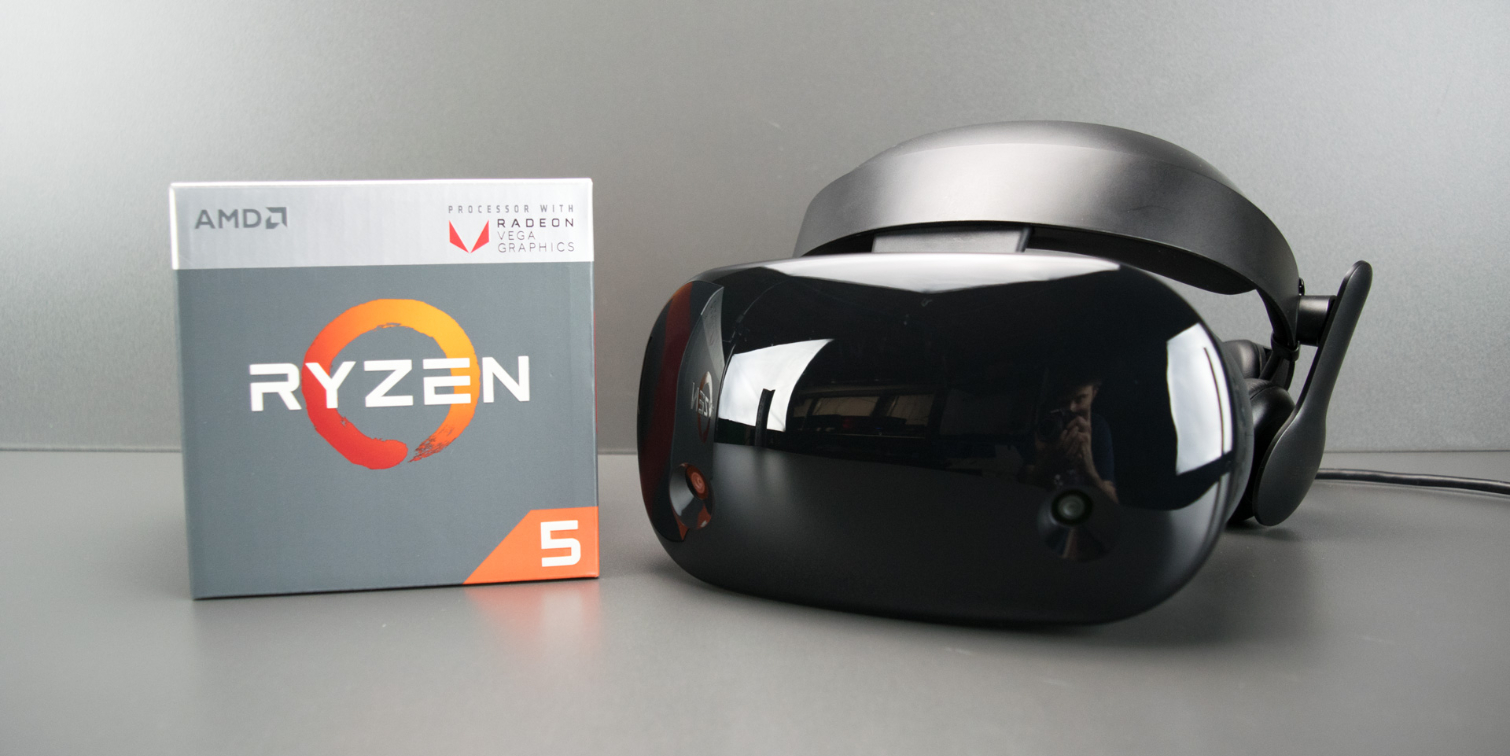A Budget VR Option? Testing AMD's Ryzen 5 2400G With Windows Mixed Reality
AMD's Ryzen 5 2400G Is Surprisingly Good for Casual Gaming
We started this experiment knowing full-well that it might fail completely, but with the hope that we might find some interesting results. As it turned out, hope was on our side, but failure wasn’t far behind. Our Ryzen 5 2400G far surpassed our hopes and our expectations. We thought AMD’s little CPU/GPU combo-chip could probably manage desktop work in an immersive environment. We never expected it to deliver a passable gaming experience in any way, and we had little hope of using it for VR video playback. But the AMD chip defied expectations and accomplished both feats, albeit with limitations on the gaming front. The AMD Ryzen 5 2400G is more than capable of handling the basic Windows Mixed Reality experience.
To be clear, we wouldn’t, by any stretch of the imagination, recommend a Ryzen 5 2400G for VR gaming. But if you stick to native Windows MR content, and casual games, it works surprisingly well.
Microsoft worked closely with Intel to promote a budget entry path to Windows Mixed Reality. But we think the tech giant missed a big opportunity to collaborate with AMD. The Ryzen 5 2400G with Vega graphics delivers a significantly better experience on Microsoft's VR platform than our Core i5 with its integrated HD Graphics 620 silicon.
What Can We Extrapolate From Our Budget VR Experiment?
We don’t necessarily recommend using a Ryzen 5 2400G for Windows Mixed Reality. Because even though headset prices have fallen (in some cases below the $250 mark), and performance graphics card pricing remains sky high, most users looking to get into the VR space probably don't want to invest several hundred dollars on a system with serious limitations. But our experience with AMD's Raven Ridge chip opened our eyes to the possibility that we may soon have access to chips with integrated graphics that are powerful enough for the demanding workload of immersive VR experiences. We wouldn’t be surprised if AMD gives its second-generation Ryzen APUs enough oomph to drive high-quality VR content. At that point, PC-based VR gaming will have a better chance of gaining mainstream traction than in the current world where highly overpriced graphics cards are required.
This experiment also gives us hope that we’ll eventually see VR on the Xbox One platform. Two years ago, Microsoft introduced the Xbox Scorpio project and said that the new console would support virtual reality. When the company dropped the new console (now called Xbox One X), it stopped talking about VR on the Xbox platform. But we always expected that the Windows Mixed Reality platform and the Xbox One platforms would eventually come together to offer a mainstream living room VR gaming experience. Microsoft's Windows Mixed Reality runs surprisingly well on a mainstream chip like the Ryzen 5 2400G without official support or optimization. So we have to image that the two companies, working together, could deliver a more-satisfying experience with the powerful SoC in the Xbox One X.
MORE: Best Virtual Reality Headsets
MORE: All Virtual Reality Content
Get Tom's Hardware's best news and in-depth reviews, straight to your inbox.
MORE: Virtual Reality Basics
Current page: AMD's Ryzen 5 2400G Is Surprisingly Good for Casual Gaming
Prev Page Using SteamVR to Benchmark VR Framerates on Integrated Vega GraphicsKevin Carbotte is a contributing writer for Tom's Hardware who primarily covers VR and AR hardware. He has been writing for us for more than four years.
-
dudmont Did you do any overclocking or tweaking of the memory on the systems? IIRC, raven ridge really benefits from both. Would it benefit enough to make any serious difference in feel or allow you to run slightly higher graphical detail settings? I know not everyone spends hours fine tuning, but AMD chips beg it.Reply -
Heliosurge Awesome Review! I agree completely. If AMD continues on this path with apu improvements will definitely help to propel vr into the mainstream. Definitely look forward to seeing their future line up & how it compares.Reply -
kcarbotte Reply20813194 said:Did you do any overclocking or tweaking of the memory on the systems? IIRC, raven ridge really benefits from both. Would it benefit enough to make any serious difference in feel or allow you to run slightly higher graphical detail settings? I know not everyone spends hours fine tuning, but AMD chips beg it.
I did not do any overclocking for this article. Mostly due to time constraints -- I only had two weeks with the CPU before it had to go back.
I also didn't spend any time trying to tweak the memory beyond 2933MHz because the memory that I have is from before Ryzen chips hit the market and it doesn't like to run at 3200MHz on my X370 boards.
That said, I don't think you would get enough of a gain from a modest overclock to make much of a difference.
30 FPS really isn't good enough for VR games. You can get by with it if you have strong VR legs, but its not something I would recommend trying.
This article is really just an experiment to set the tone of the current state of affairs. Wait a year or two and we'll probably be having a completely different discussion. -
Plumboby Give AMD a few months drivers will get better they are doing drivers atm to suit the Apu as we speak as driver wise is lucky dip. THink about it new tech new aritecture new bugs new problems to iron out give them a few moths to iron out the kinks & markets to stabilise a bit & I suggest that With the Ryzen 2s coming out they probly going do a mass driver Bios, motherboard hit out to suit any issues. I know off hand that they are currently beefing up the drivers with odd glitches that have filtered threw being a new Apu.Reply -
ZRace Great little review, I didn't expect the APU to drive such high resolutions in VR that well.Reply -
Rookie_MIB Imagine if AMD put together a custom APU with 20 CU's.... That would make for almost (I think) a near 60fps experience. That would be a VERY usable VR chip.Reply -
kcarbotte Reply20813544 said:Great little review, I didn't expect the APU to drive such high resolutions in VR that well.
Haha, thanks!
Nor did I! -
nate1492 How low are your standards for passable VR? How does 20-30 FPS in *FRUIT NINJA* get anything but laughed out the building?Reply
Do you want to get sick while playing VR? This is how you get sick playing VR.
To be clear. If you bought this CPU and a VR headset, there is a *very strong chance you would be ill while playing this*.
This review barely touches on this fact. It's hard enough to not feel ill below 60 or 90 FPS, but 20-30 with high frame latency will feel awful. -
Nino LS Did you skip over the section where native WMR titles ran excellent? "It managed to run Halo Recruit with ease." They did not recommend this chip for SteamVR, where all the lower frame rates you cite happened. The point is an APU is running modern VR and running it well in it's native ecosystem - this is great news for all VR users .....and those that don't even know they will be using it yet.Reply -
kcarbotte Reply20814745 said:How low are your standards for passable VR? How does 20-30 FPS in *FRUIT NINJA* get anything but laughed out the building?
Do you want to get sick while playing VR? This is how you get sick playing VR.
To be clear. If you bought this CPU and a VR headset, there is a *very strong chance you would be ill while playing this*.
This review barely touches on this fact. It's hard enough to not feel ill below 60 or 90 FPS, but 20-30 with high frame latency will feel awful.
I didn't at any point recommend using an APU for Steam VR. I clearly stated we used those games for benchmarks because you can't run FCAT VR in the Windows MR environment.
30 fps is not passable VR, but it exceeded my expectations.

